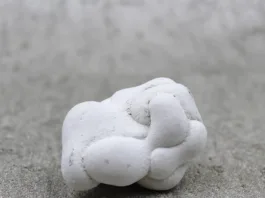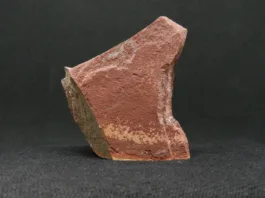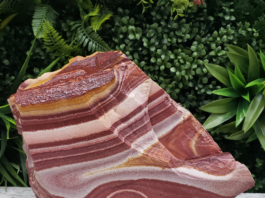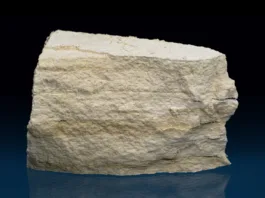Petoskey Stone is a type of fossilized coral that holds significance and popularity, particularly in the state of Michigan, USA.

Origin: Petoskey Stone is a fossilized coral, specifically a type of colonial coral known as Hexagonaria percarinata. The stone gets its name from the city of Petoskey in Michigan, where it is commonly found.
Appearance: Petoskey Stones are characterized by a unique pattern of hexagonal shapes on their surface. These hexagon-shaped fossilized coral polyps create a distinctive “honeycomb” or “starburst” pattern.
Composition: The stone is composed of the fossilized remains of ancient coral creatures, and it is primarily made of calcium carbonate. Over time, the coral skeletons were replaced by minerals, resulting in the preservation of the hexagonal pattern.

Geological History: Petoskey Stones are estimated to be around 350 million years old, dating back to the Devonian period. They offer a glimpse into the ancient geological history of the Great Lakes region.
Cultural Symbolism: In Michigan, Petoskey Stones hold cultural significance and are often used in jewelry, crafts, and as decorative items. They are considered the state stone of Michigan.
Collectibility: Collecting Petoskey Stones is a popular hobby among locals and tourists alike. Many people enjoy combing the shores of Lake Michigan, especially in the Petoskey area, in search of these unique and fossilized treasures.
Craftsmanship: Due to its distinctive pattern and hardness, Petoskey Stone is often polished and used in various artistic and decorative applications. It is commonly crafted into jewelry, keychains, and other keepsakes.
Contents
Popularity:
1. Tourism: The popularity of Petoskey Stones contributes to tourism in the Great Lakes region, particularly in Michigan. Tourists are drawn to the shores of Lake Michigan for the opportunity to find and collect these distinctive fossils.
2. Souvenirs and Merchandise: Petoskey Stones have become a symbol of Michigan, and various souvenirs and merchandise featuring these stones are widely available. This includes everything from jewelry and home decor to shirts and accessories.
3. Art and Crafts: Artists and craftsmen use Petoskey Stones as raw materials for creating unique and visually appealing pieces. The stone’s natural beauty and historical significance make it a popular choice in various creative projects.
In summary, Petoskey Stone is more than just a fossilized coral; it’s a symbol of Michigan’s geological history and a cherished item for collectors, artisans, and those who appreciate its unique beauty.
Geological Background of Petoskey Stone

1. Location:
- Petoskey Stones are primarily found in the northern regions of Michigan, particularly along the shores of Lake Michigan, Lake Huron, and their tributary rivers. The city of Petoskey, Michigan, lends its name to these distinctive fossilized corals.
2. Geological Setting:
- The geological setting of the Petoskey Stone formation dates back to the Devonian period, approximately 350 million years ago. During this time, the region that is now Michigan was covered by a warm, shallow sea.
Formation Process:

1. Colonial Coral Formation:
- Petoskey Stones are the remains of colonial coral known as Hexagonaria percarinata. These corals lived in large colonies, and over time, their skeletons accumulated on the sea floor.
2. Fossilization:
- As the coral colonies died, their skeletons were buried by sediment, preventing immediate decomposition. Over millions of years, the coral skeletons underwent a process of fossilization.
3. Replacement of Minerals:
- The fossilization process involved the gradual replacement of the original calcium carbonate skeleton with minerals such as silica. This process helped preserve the intricate hexagonal pattern of the coral polyps.
4. Uplift and Exposure:
- Geological forces, including tectonic activity and uplift, exposed the fossilized coral beds to the surface. Erosion gradually wore away the overlying rocks, bringing the Petoskey Stones closer to the surface.
5. Glacial Action:
- During the Pleistocene epoch, glacial activity further shaped the landscape of the Great Lakes region. Glacial movements scoured the surface and deposited sediments, bringing Petoskey Stones to areas where they can be easily found today.
Geological History of Petoskey Stone

1. Devonian Period:
- The Devonian period, spanning from approximately 419 to 359 million years ago, was marked by the development of complex marine ecosystems. It was during this time that the colonial coral Hexagonaria percarinata thrived in the warm, shallow seas.
2. Glacial Influence:
- The geological history of Petoskey Stones involves not only their initial formation but also the impact of glacial activity during the Quaternary period. Glacial movements played a crucial role in shaping the landscape and bringing these fossils closer to the surface.
3. Post-Glacial Landscape:
- The post-glacial landscape of the Great Lakes region, shaped by the retreat of glaciers, further exposed the fossilized coral beds. This allowed for the discovery and collection of Petoskey Stones by enthusiasts and researchers alike.
In summary, the geological background of Petoskey Stones is closely tied to the Devonian period when colonial coral colonies thrived in the warm seas of what is now Michigan. The subsequent processes of fossilization, uplift, and glacial activity contributed to the formation and exposure of these unique fossilized corals in the present-day landscape.
Identification and Characteristics of Petoskey Stones

**1. Color and Pattern:
- Petoskey Stones are typically light gray or beige in color. The most distinctive feature is the hexagonal pattern on the surface, resembling a honeycomb or starburst. The pattern is a result of the fossilized coral polyps and their interconnected hexagonal shapes.
2. Texture:
- The surface of Petoskey Stones is often smooth, and when polished, it can reveal a glossy finish. The stone can have a porous texture, especially in its natural state, and may absorb water, causing it to darken temporarily.
3. Hardness:
- Petoskey Stones have a hardness ranging from 4 to 5 on the Mohs scale. This level of hardness makes them suitable for polishing and carving, contributing to their use in jewelry and crafts.
4. Shape:
- The overall shape of Petoskey Stones can vary, but they are generally rounded or oval. Their shape is influenced by natural weathering and erosion. Some may be relatively flat, while others can be more three-dimensional.
5. Size:
- Petoskey Stones come in various sizes, ranging from small, pebble-sized specimens to larger stones that can fit in the palm of your hand. The size is influenced by factors such as the original size of the coral colony and subsequent geological processes.
6. Fossilized Structures:
- On closer inspection, one may observe fossilized structures within the hexagonal patterns. These structures represent the individual polyps of the colonial coral. The fossils can provide insights into the ancient marine life that existed during the Devonian period.
7. Location:
- Petoskey Stones are primarily found along the shores of Lake Michigan, Lake Huron, and their tributary rivers in northern Michigan. The stones are often discovered on beaches, riverbanks, or in gravel pits where glacial activity and erosion have exposed them.
8. UV Fluorescence:
- Some Petoskey Stones exhibit fluorescence under ultraviolet (UV) light. This characteristic is not present in all specimens, but when it occurs, it adds an interesting visual element to the stones.
9. Craftsmanship:
- Due to its unique pattern and hardness, Petoskey Stone is often shaped and polished for use in various crafts. It is commonly incorporated into jewelry, carvings, and decorative items, showcasing the stone’s natural beauty.
10. Buoyancy:
- Petoskey Stones are denser than water, so they will sink when placed in water. This can be a helpful characteristic for individuals who enjoy searching for them along shorelines, as they tend to be found in areas where they have settled after being carried by water currents.
In summary, the identification of Petoskey Stones involves recognizing their distinct color, hexagonal pattern, texture, and fossilized structures. These characteristics, along with their geological context and location, contribute to their popularity among collectors and enthusiasts.
Distribution

The distribution of Petoskey Stones is primarily centered around the northern regions of Michigan, USA, and certain areas within the Great Lakes region. Here are key points regarding their distribution:
- Michigan:
- Petoskey Stones are most commonly found in Michigan, particularly along the shores of Lake Michigan and Lake Huron. The city of Petoskey, after which the stone is named, is located in the northern part of the Lower Peninsula of Michigan. The stones can be found on beaches, riverbanks, and in gravel pits in this region.
- Lake Michigan and Lake Huron:
- The shores of Lake Michigan and Lake Huron, two of the Great Lakes, are known for being rich sources of Petoskey Stones. The stones are often discovered along the water’s edge, where they have been exposed by the action of waves, currents, and glacial processes.
- Tributary Rivers:
- Petoskey Stones can also be found in the vicinity of rivers that flow into the Great Lakes. The stones may be carried by water currents from their original locations and deposited along the banks of these rivers.
- Glacial Deposits:
- The geological history of the region, including glacial activity during the Pleistocene epoch, has influenced the distribution of Petoskey Stones. Glacial movements played a role in transporting and depositing these stones in various locations within the Great Lakes basin.
- Other Localities:
- While Michigan is the primary source of Petoskey Stones, there have been occasional reports of similar fossils in other regions with comparable geological conditions. However, the stones’ concentration and abundance are highest in the northern parts of Michigan.
- Collection Hotspots:
- Specific areas along the shores of Lake Michigan, Lake Huron, and popular beaches in the Petoskey region are known as hotspots for collecting Petoskey Stones. Enthusiasts often visit these locations in search of these unique fossilized corals.
It’s important to note that while Petoskey Stones have a concentrated distribution in Michigan, their presence is not limited exclusively to the state. The stones have been carried by glacial and water processes, leading to their occasional discovery in other parts of the Great Lakes region. However, the most prolific and well-known sources are associated with the state of Michigan.
Cultural and Historical Significance

Petoskey Stones hold cultural and historical significance, particularly in the state of Michigan, where they are cherished as both a geological marvel and a symbol of the region’s natural heritage. Here are key points highlighting their cultural and historical importance:
**1. State Stone of Michigan:
- Petoskey Stone is officially recognized as the state stone of Michigan. This designation emphasizes its cultural importance and contribution to the identity of the state.
**2. Symbol of Michigan:
- Petoskey Stones have become a symbol of Michigan, representing the state’s geological history and unique natural treasures. They are often featured in state-related merchandise, logos, and promotional materials.
**3. Tourism and Souvenirs:
- The cultural significance of Petoskey Stones contributes to tourism in the Great Lakes region. Tourists are drawn to Michigan’s shores, particularly around Lake Michigan, to search for and collect these distinctive fossils. The stones are also popular choices for souvenirs and memorabilia.
**4. Native American Influence:
- The Native American tribes indigenous to the region, such as the Odawa, Ojibwa, and Potawatomi, have long held cultural connections to the land. While specific historical uses of Petoskey Stones by these tribes may not be well-documented, the stones are a part of the broader natural landscape that has cultural significance for indigenous communities.
Historical Significance:

**1. Devonian Period Fossils:
- Petoskey Stones offer a unique window into the geological history of the Great Lakes region. The fossils date back to the Devonian period, around 350 million years ago, providing a tangible link to the ancient marine life that once inhabited the area.
**2. Glacial Legacy:
- The distribution of Petoskey Stones is influenced by glacial activity during the Pleistocene epoch. The stones’ presence in specific locations and their exposure due to glacial deposits contribute to the historical narrative of the region’s geological evolution.
**3. Native American Traditions:
- While the specific historical use of Petoskey Stones by Native American tribes might not be extensively documented, the stones are part of the broader natural landscape that has historical and cultural significance for these communities.
**4. Cultural Crafts and Art:
- The historical significance of Petoskey Stones is also evident in their use in various crafts and art forms. The stones are carved, polished, and incorporated into jewelry, sculptures, and decorative items, showcasing the historical and aesthetic value attributed to them.
In summary, Petoskey Stones are culturally significant as a symbol of Michigan and a popular attraction for tourists. Their historical importance lies in their connection to the Devonian period and the Pleistocene epoch, as well as their use in Native American traditions and contemporary art and crafts.
Application and Uses Areas of Petoskey Stone

Petoskey Stones find applications and uses in various areas, ranging from artistic and decorative endeavors to geological education. Here are some key application areas:
Jewelry and Accessories:
- Petoskey Stones are often used in the creation of unique and distinctive jewelry pieces. Craftsmen cut, shape, and polish the stones to highlight their natural beauty, creating earrings, necklaces, bracelets, and other accessories.
Craftsmanship:
- Artisans and craftsmen utilize Petoskey Stones for a wide range of artistic and decorative purposes. The stones can be carved into intricate designs, used in mosaics, or integrated into sculptures and decorative items.
Home Decor:
- Petoskey Stones are incorporated into home decor items such as coasters, paperweights, and display pieces. Their distinctive hexagonal patterns and natural beauty make them appealing additions to interior design.
Educational Displays:
- In educational settings, Petoskey Stones are used to illustrate concepts related to paleontology, geology, and the Devonian period. They can be part of museum displays, teaching aids, or geological exhibits, providing hands-on learning opportunities.
Souvenirs and Gifts:
- Due to their cultural significance, Petoskey Stones are popular choices for souvenirs and gifts. Visitors to the Great Lakes region often purchase items crafted from Petoskey Stones as mementos of their experiences.
Lapidary Arts:
- Lapidaries, individuals who cut and polish gemstones, use Petoskey Stones in lapidary arts. The stones can be shaped into cabochons, beads, or other forms for use in custom jewelry or ornamental pieces.
Metaphysical and Spiritual Practices:
- Some individuals incorporate Petoskey Stones into metaphysical and spiritual practices. The stones are believed by some to possess energy and healing properties, making them sought after in certain holistic and alternative health communities.
Landscaping and Garden Design:
- Petoskey Stones are sometimes used in landscaping and garden design to add a unique and natural element to outdoor spaces. They may be embedded in pathways, incorporated into rock gardens, or used as decorative accents.
Geological Collections:
- Collectors often include Petoskey Stones in their geological collections. These specimens serve as tangible representations of the ancient marine life from the Devonian period and are valued by enthusiasts interested in paleontology and earth sciences.
Artistic Creations:
- Artists use Petoskey Stones as mediums for creative expressions. The unique patterns and textures of the stones inspire various artistic creations, including paintings, sculptures, and mixed-media artwork.
In summary, Petoskey Stones have versatile applications in the realms of art, jewelry, home decor, education, and more. Their unique characteristics make them prized materials for those who appreciate their aesthetic and cultural significance.






